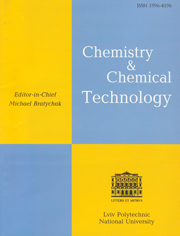Disruption of Yeast Cells Xanthophyllomyces Dendrorhous (Phaffia Rhodozyma) by Vibration Resonant Low-Frequency Cavitator
| Attachment | Size |
|---|---|
| 1.41 MB |
[1] Akiba, Y.; Sato, K.; Takahashi, K.; Matsushita, K.; Komiyama, H.; Tsunekawa, H.; Nagao, H. Meat Color Modification in Broiler Chickens by Feeding Yeast Phaffia rhodozyma Containing High Concentrations of Astaxanthin. J. Appl. Poult. Res. 2001, 10, 154-161. https://doi.org/10.1093/japr/10.2.154
https://doi.org/10.1093/japr/10.2.154
[2] Stefanyshyn, O.M.; Nechay, H.I.; Boretska, N.I.; Hural, S.V.; Tsepko, N.І. Profilaktychnyi ta korerhuyuchyi vplyv kormovoi dobavky karotynosyntezuvalnykh drizhdzhiv Phaffia rhodozyma na formuvannia mikrobotsenozu kyshkivnyka kurei pid chas
krytychnogo periodu yoho stanovlennia. Biologia tvaryn 2013, 15, 125-131. http://nbuv.gov.ua/UJRN/bitv_2013_15_3_19
[3] Shoja, B.; Ahmadi, A.R.; Rafiee, F.; Manavi, P.N. Influence of Probiotic Yeast Phaffia rhodozyma on Growth, Survival and Ma-turity of Artemia Urmiana. Asian J. Exp. Biol. Sci. 2012, 3, 355-359.
[4] Jacobson, C.K.; Jolly, S.O.; Sedmak, J.J.; Skatrud, T.J.;
Wasileski, J.M. Astaxanthin Over-Producing Strains of Phaffia rhodozyma. Method for their Cultivation and their Use in Animal Feeds. US 6015684, January 18, 2000.
[5] Choi, J.; Rahman, M.M.; Lee, S.Y.; Chang, K.H.; Lee, S.M. Effects of Dietary Inclusion of Fermented Soybean Meal with
Phaffia rhodozyma on Growth, Muscle Pigmentation, and
Antioxidant Activity of Juvenile Rainbow Trout (Oncorhynchus mykiss). Turkish J. Fish. Aquat. Sci. 2016, 16, 91-101 https://doi.org/10.4194/1303-2712-v16_1_10
https://doi.org/10.4194/1303-2712-v16_1_10
[6] Perenlei, G.; Tojo, H.; Okada, T.; Kubota, M.; Kadowaki, M.; Fujimura, S. Effect of Dietary Astaxanthin Rich Yeast, Phaffia rhodozyma, on Meat Quality of Broiler Chikens. Anim. Sci. J. 2014, 85, 895-903. https://doi.org/10.1111/asj.12221
https://doi.org/10.1111/asj.12221
[7] Wu, W.; Yu, X. Optimization of Ultrasound-assisted Extraction Procedure to Determine Astaxanthin in Xanthophyllomyces
dendrorhous by Box-Behnken Designn. Adv. J. Food Sci. Technol. 2013, 5, 1536-1542. http://dx.doi.org/10.19026/ajfst.5.3381
https://doi.org/10.19026/ajfst.5.3381
[8] Dos Santos Da Fonseca, R.A.; da Silva Rafael, R.; Kalil, S.J.; Burkert, C.A.V.; Burkert, J.F.M. Different Cell Disruption Methods for Astaxanthin Recovery by Phaffia rhozyma. Afr. J. Biotechnol. 2011, 10, 1165-1171. DOI: 10.5897/AJB10.1034
[9] Michelon M., de Matos de Borba, T.; da Silva Rafael, R.;
Burkert, C.A.V.; Burkert, J.F.M. Extracttion of Carotenoids from Phaffia rhodozyma: A Comparison between Different Techniques of Cell Disruption. Food Sci. Biotechnol. 2012, 21, 1-8. https://doi.org/10.1007/s10068-012-0001-9
https://doi.org/10.1007/s10068-012-0001-9
[10] Okagbue, R.N.; Lewis, M.J. Autolysis of the Red Yeast Phaffia rhodozyma: A Potential Tool to Facilitate Extraction of Astaxanthin. Biotechnol. Lett. 1984, 6, 247-250. https://doi.org/10.1007/BF00140045
https://doi.org/10.1007/BF00140045
[11] Yaakob Z.; Ali, E.; Zainal, A.; Mohamad, M.; Takriff, M.S. An Overview: Biomolecules from Microalgae for Animal Feed and Aquaculture. Journal of Biological Research-Thessaloniki 2014, 21, 6. https://doi.org/10.1186/2241-5793-21-6
https://doi.org/10.1186/2241-5793-21-6
[12] El Khoury, D.; Cuda, C.; Luhovyy, B.L.; Anderson, G.H. Beta Glucan: Health Benefits in Obesity and Metabolic Syndrome. J. Nutr. Metab. 2012, 28. https://doi.org/10.1155/2012/851362
https://doi.org/10.1155/2012/851362
[13] Manners, D. J.; Masson, A. J.; Patterson, J.C. The Structure of a β-(1→3)-D-glucan from Yeast Cell Walls. Biochem. J. 1973, 135, 19-30. https://doi.org/10.1042/bj1350019
https://doi.org/10.1042/bj1350019
[14] Vilkhu, K.; Mawson, R.; Simons, L.; Bates, D. Applications and Opportunities for Ultrasound Assisted Extraction in the Food Industry - A Review. Innov. Food Sci. Emerg. Technol. 2008, 9, 161-169. https://doi.org/10.1016/j.ifset.2007.04.014
https://doi.org/10.1016/j.ifset.2007.04.014
[15] Shevchuk, L.; Strogan, O.; Koval, I. Equipment for Magnetic-Cavity Water Disinfection. Chem. Chem. Technol. 2012, 6, 219-223. https://doi.org/10.23939/chcht06.02.219
https://doi.org/10.23939/chcht06.02.219
[16] Gural, S.V.; Kolysnyk, G.V.; Klymyshyn, D.О.; Gonchar M.V. Doslidzgennya skladu karotynoidiv u mutantav drizhdzhiv Phaffia rhodozyma (Xanthophyllomyces dendrorhous). Biotekhnolohia 2011, 4, 93-100.
[17] Salyha, Yu.T.; Snitynskyi, V.V. Elektronna mikroskopia biolohichnylh ob'yektiv; Svit: Lviv, 1999.
[18] Koval, I.; Starchevskyy, V. Gas Nature Effect on the Destruc-tion of Various Microorganisms under Cavitation Action. Chem. Chem. Technol. 2020, 14, 264-270. https://doi.org/10.23939/chcht14.02.264
https://doi.org/10.23939/chcht14.02.264
[19] Koval, I.Z.; Kіslenko, V.N.; Starchevskii, V.L.; Shevchuk, L.I. The Effect of Carbon Dioxide on the Viability of Bacteria of
Bacillus and Diplococcus Genera. J. Water Chem. Technol. 2012, 34, 112-116. https://doi.org/10.3103/S1063455X12020075
https://doi.org/10.3103/S1063455X12020075
[20] Predzumirska, L.M.; Falyk, T.S.; Shevchuk, L.I.; Nykulyshyn, I.E.; Chaikivskyi, T.V. Efertyvnist kavitatsinoho ochycschennia vody v zaleznosti vid pryrody barbotovanoho hazu. Visnyk
Kremenchutskoho Natsionalnoho Universytetu 2016, 97, 102-109.










